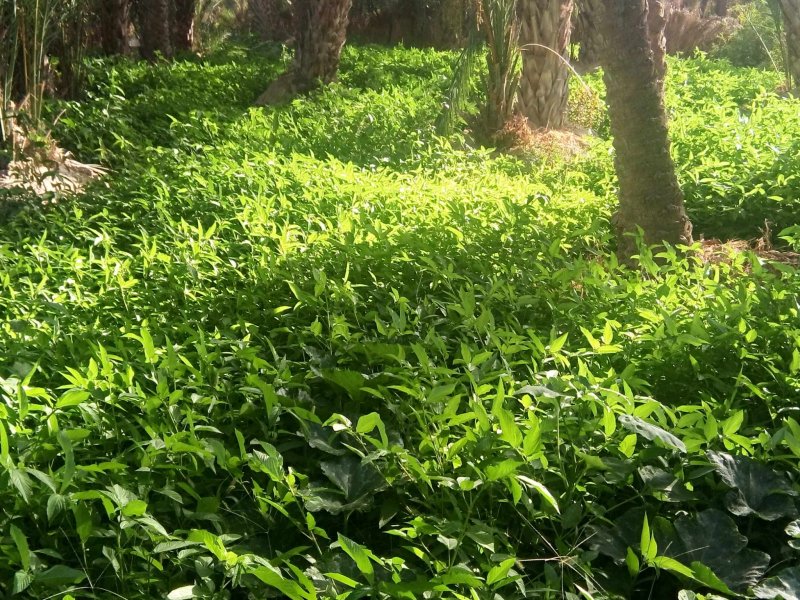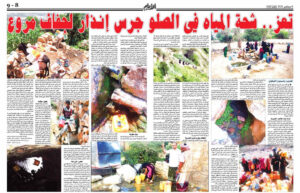This article is quoted from Raseef website - link to the original article published on Wednesday, February 28, 2024 here
The oases in southern Tunisia extend over a distance of about 40 thousand hectares, and contain more than 5 million palm trees, most of which are excellent varieties. Although the production of dates in the oases has developed from 73 thousand tons in the mid-nineties to 390 thousand in the 2023-2024 season, and Tunisia has ranked first in exporting dates in the world, this development, despite its importance in the economic aspect, has very serious consequences on the environment, especially in light of weather changes.
In recent years, Tunisia has been facing a scarcity of precipitation that has caused the drying up of water sources in the south, “Laayoune.” So farmers resorted to digging random wells, which caused the depletion of groundwater. This gross exploitation of natural resources did not solve the problem, as the temperature rose to record levels and the lack of rain caused... The emergence of the dust spider pest, which destroyed dates and caused the destruction of crops, and the salinization of water in the region became a real threat to the sustainability of the oases.
The oases in southern Tunisia extend over a distance of about 40 thousand hectares and contain more than 5 million palm trees.
The impact of climate changes on the oases is highlighted by the change in the production system, which consisted of three layers: the lower layer was prepared for the production of vegetables, the middle layer for the production of fruit trees such as olives, pomegranates, and peaches, and the upper layer for palm trees. However, due to climate changes, the oasis in many areas only maintained the production of dates.
The farmer could no longer stand
Karim Ben Shaaban, a farmer and head of the development complex in Tamerza, points out that the oases in the region are ancient and famous for their mountainous terrain, and contain natural springs that represent the only source of irrigation, unlike other oases that base their irrigation on wells, but the retention of rain in recent years has become a threat. He is serious about water resources in the region, and points out that the process of irrigating his oasis was completed in two hours, but 120 minutes is currently no longer enough to saturate the soil, and the situation is that the water cycle is distributed among the farmers and the specified time cannot be exceeded.
In his interview with Raseef22, Bin Shaaban explains that the decline in water levels has serious repercussions on the vegetables and grains produced by the oasis, as these crops are no longer able to withstand high temperatures and water scarcity, and the quality of dates is deteriorating.
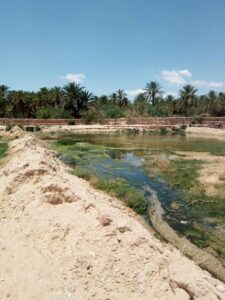
Al-Falah spoke about the dust spider scourge, which is known in the region as “bufarwa,” which is also one of the consequences of climate change. He said: “Reduced rain contributed to the spread of the dust spider scourge, and high temperatures also helped in its rapid spread and obstructed the process of dealing with it, which requires many Of appropriate medications and mechanisms. The spread of this pest forces the farmer to cut down his produce and burn it to eliminate the dust spider. Instead of the farmer reaping the fruits of his labor, he is forced to hire workers to cut the date branches and burn them or bury them under the ground.”
The speaker believes that climate change will destroy the oases, which mainly suffer from problems of fragility, poor productivity, and scarcity of natural resources, and force the farmer to become like a soldier on the outskirts, watching day and night. In the end, he is confronted with the reality of the high cost of labor and the difficulties witnessed by the agricultural sector in general, and he is unable to even To cover production costs.
He concludes by affirming that Tamerza is an excellent tourist destination famous for its waterfalls, springs and excellent natural landscapes, which can be exploited through eco-tourism to benefit the region and its people.

One of the oases in southern Tunisia
A third of the oases have disappeared
The phenomenon of displacement from the countryside to the cities affects almost all inland regions. However, for years the people of the south have clung to stability in the desert and adapted to its climate. However, climate fluctuations in recent years have increased the harshness of nature and harmed all the activities of farmers there, whether raising livestock, such as camels and goats, or Irrigated agriculture, which prompted many people in the south to seriously think about settling in cities in search of a source of livelihood.
In addition to climate changes, some oases complain of pollution caused by the chemical complex stationed in Gabès, and “phosphogypsum” has caused the elimination of the oasis in the region.
In the face of all these challenges, many civil societies seek to save what can be saved, shed light on environmental problems, and raise awareness of the necessity of finding solutions that serve sustainable development in these areas.
Noufal Hamouda, head of the Association for the Preservation of Wetlands in Southern Tunisia, believes that the oases are considered wet areas, but they are artificial, and the problems related to them are many and complex according to the specificity of each one. The coastal oasis in Gabes, which is unique in the Mediterranean and rare in the world, has special problems summed up in pollution. Urban expansion will destroy the oasis and affect the natural landscape and the water network.
Climate changes will eliminate the oases, which mainly suffer from problems of fragility, poor productivity, and scarcity of natural resources, and force the farmer to become like a soldier on the border, watching day and night, and in the end he is confronted with the reality of the high cost of labor and the difficulties witnessed by the agricultural sector.
Hamouda told Raseef22 that the inland oases of Kebili and Douz, the mountainous oases of Tozeur and Tataouine, and also the Gabes Oasis, share an important and major problem, which is the scarcity of water, the high frequency of randomly drilling wells, and the weakness of the water supply, which would disrupt the water cycles, especially in the coastal oases, because all A farmer needs a water cycle every 15 days, and because of the outstanding problems, the farmer does not get water until after 40 days or more.
He explains that the division of water in oases has existed since the Roman era. Irrigation water is passed from one oasis to another according to the required area and quantity, and water associations supervise this process, but administrative corruption is ravaging it, and mismanagement of water further exacerbates the situation.
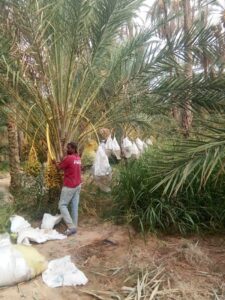
One of the oases in southern Tunisia
He talks about the architecture of the oasis consisting of waterways in which water flows smoothly and in stages from one oasis to another, but neglected oases cause disturbance in these paths and hinder the arrival of water to the exploited oases. He also points out that filtration paths are sewage networks that rid the oases of excess water. Watering is needed intermittently, so the filtration process is not complete and salts remain in the oases, which is one of the reasons for eliminating plant diversity. The high salinity of water in some areas also leads to the death of large areas.
In addition to the natural problems rooted in the oases, the dispersion of ownership after the division of inheritance causes the shrinkage of their areas and the weakening of their returns.
Hamouda denounces the weakness of the state’s intervention in the oases and the lack of this sector in special legislation, despite the association’s repeated demands to establish a special office for the oases, which would undertake to solve the outstanding problems. He considers that the current laws are general and do not take into account the specificity of the palm oases. He also points out that the economic aspect is an obstacle to the development of the oasis. It makes the production of some of them worthless, such as the types of lamthi and bu hatham, which could have been exploited in the sugar industry, for example, but this is not done due to the high cost.
He confirms that a third of the oases have disappeared, and the oasis areas are about to decline, which is a dangerous indicator in light of the lack of establishing new oases, and this is coupled with a large economic return. He indicates that some farmers have shifted from producing dates and olives to projects for fattening calves and feeding cows, which are projects that are not compatible with the oasis. And it can increase epidemics that affect crops and plants.
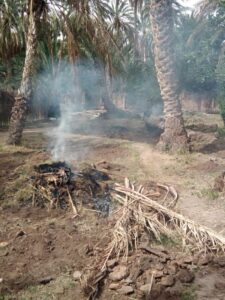
One of the oases in southern Tunisia
Ill-conceived export policies
Although climatic factors have contributed to negatively affecting the Tunisian oases, the production system that only takes into account global competitiveness has in turn harmed the biological richness of the oasis, by focusing on the production of certain types of dates, such as Deglet Nour, and neglecting other types, despite the fact that the Tunisian oases produce 200 varieties. Among them are blackberries, fatimi, dates, and others.
Environmental expert Muhammad bin Saleh believes that the export policy is linked to the production policy, and the dates produced, whether intended for export or for local consumption, have the same environmental impacts, including water consumption, indicating that the production pattern is responsible for water consumption, as the flood irrigation method consumes more water than local irrigation.
The production system, which only takes into account global competitiveness, has in turn harmed the biological richness of the oasis, by focusing on the production of certain types of dates, such as Deglet Nour, and neglecting other types, even though the Tunisian oases produce 200 varieties, including blackberries, fatimi, dates, and others.
In his interview with Raseef22, the expert pointed out that the oasis systems in Tunisia and other date-producing countries are located in arid regions with a dry and hot climate, due to the palm’s requirements for heat, as it is a plant whose stem grows in water and its head in extreme heat, and the production of palm trees of all kinds depends on irrigation. There is no difference in the water needs of date varieties, but Deglet El Nour needs standard temperatures and therefore does not grow in coastal oases.
It is considered that the lack of rain has an indirect effect, given that palm cultivation depends on irrigation, but rain has an effect on recharging the aquifers that represent a source of irrigation water. It also affects the salinity of the soil, washing it away from the salts that seep to the bottom, and thus the lack of precipitation It has an impact on agriculture in general, including oasis agriculture.


